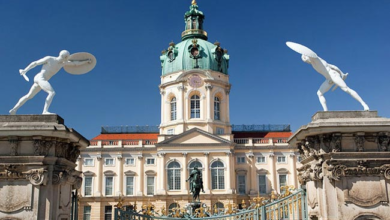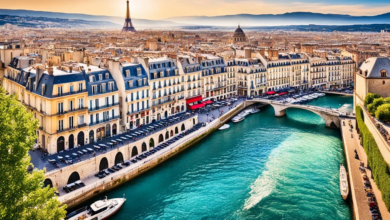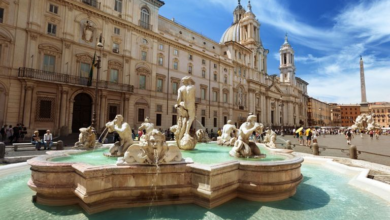Discovering Austria: A Guide to Top Hotels and Attractions
Introduction
Austria, a land of stunning alpine landscapes, rich history, and vibrant culture, offers a diverse array of experiences for travelers. From the imperial grandeur of Vienna to the enchanting beauty of the Alps, Austria is a destination that captivates the heart and soul. This article explores the best Austrian hotels and must-see attractions to help you plan an unforgettable visit to this Central European gem.
Best Austrian Hotels
Vienna
- Hotel Sacher Wien
- Overview: Renowned for its luxury and history, Hotel Sacher Wien is a five-star hotel located near the State Opera House. It offers opulent rooms, exceptional service, and the famous Sacher-Torte.
- Amenities: Fine dining restaurants, a luxurious spa, and elegantly decorated rooms.
- The Ritz-Carlton, Vienna
- Overview: Situated on the famous Ringstrasse, this luxury hotel combines historic charm with modern elegance. Guests can enjoy stunning views of the city and top-notch amenities.
- Amenities: Rooftop bar, indoor pool, spa, and Michelin-starred restaurant.
Salzburg
- Hotel Goldener Hirsch
- Overview: Located in the heart of Salzburg’s Old Town, this historic hotel offers a blend of traditional Austrian charm and modern comforts. It’s a perfect base for exploring the birthplace of Mozart.
- Amenities: Gourmet restaurants, beautifully appointed rooms, and proximity to major attractions.
- Schloss Mönchstein Hotel
- Overview: Perched on a hill overlooking Salzburg, this castle hotel offers breathtaking views and a tranquil setting. The luxurious rooms and impeccable service make for a memorable stay.
- Amenities: Outdoor infinity pool, fine dining, and extensive spa facilities.
Innsbruck
- Grand Hotel Europa
- Overview: This historic hotel in the heart of Innsbruck combines traditional Tyrolean style with modern luxury. It’s ideally located for exploring the city’s cultural and natural attractions.
- Amenities: Gourmet restaurant, wellness area, and elegant rooms with mountain views.
- NALA Individuellhotel
- Overview: A boutique hotel with a unique design, NALA offers individually decorated rooms and a creative atmosphere. It’s a perfect choice for those seeking something different.
- Amenities: Garden, fitness center, and eclectic decor.
Top Attractions in Austria
Vienna
- Schönbrunn Palace
- Overview: This former imperial summer residence is a UNESCO World Heritage site. Explore its opulent rooms, vast gardens, and the world’s oldest zoo.
- Highlights: Grand Tour, Gloriette, and the Palm House.
- St. Stephen’s Cathedral (Stephansdom)
- Overview: An iconic Gothic cathedral in the heart of Vienna, St. Stephen’s offers stunning architecture and panoramic city views from its towers.
- Highlights: South Tower climb, catacombs, and beautiful stained glass windows.
- Belvedere Palace
- Overview: A baroque masterpiece, the Belvedere consists of two palaces housing an impressive art collection, including works by Gustav Klimt.
- Highlights: The Kiss by Klimt, beautiful gardens, and the Marble Hall.
Salzburg
- Hohensalzburg Fortress
- Overview: One of the largest and best-preserved medieval castles in Europe, offering stunning views of Salzburg and the Alps.
- Highlights: Fortress Museum, Reckturm, and panoramic views.
- Mirabell Palace and Gardens
- Overview: A baroque palace with beautifully landscaped gardens, famous for being a filming location in “The Sound of Music.”
- Highlights: Pegasus Fountain, Marble Hall, and the Dwarf Garden.
- Mozart’s Birthplace
- Overview: Visit the house where Wolfgang Amadeus Mozart was born and learn about his life and legacy.
- Highlights: Original instruments, family portraits, and historical exhibits.
Innsbruck
- The Golden Roof (Goldenes Dachl)
- Overview: A landmark in Innsbruck’s Old Town, the Golden Roof is a late Gothic oriel with a roof covered in 2,657 fire-gilded copper tiles.
- Highlights: Museum inside the building, historical significance, and picturesque setting.
- Innsbruck Nordkette
- Overview: A cable car ride takes you from the city center to the top of the Nordkette mountain range, offering spectacular views and outdoor activities.
- Highlights: Panoramic views, hiking trails, and skiing in winter.
- Ambras Castle
- Overview: A Renaissance

Austria is a country known for its rich cultural heritage. In addition to the major attractions like Vienna’s palaces and Salzburg’s music festivals, there are several unique cultural experiences visitors can have in Austria. Here are a few suggestions:
- Attending a Traditional Folk Festival: Austria has a strong tradition of folk culture, and attending a folk festival provides a glimpse into the country’s vibrant traditions. These festivals often feature lively music, traditional costumes, dancing, and local crafts. The Innsbrucker Tanzsommer in Innsbruck and the Steirischer Herbst festival in Graz are popular events to explore.
- Visiting Wine Regions: Austria has several picturesque wine regions, such as Wachau, Kamptal, and Burgenland. Wine enthusiasts can take part in wine tours and tastings, visit vineyards and cellars, and learn about the country’s winemaking traditions. Don’t miss the opportunity to try Grüner Veltliner, Austria’s signature white wine.
- Exploring the Wachau Valley: The Wachau Valley, a UNESCO World Heritage site, is a stunning region known for its scenic landscapes, charming villages, and historic monasteries. Visitors can take leisurely boat rides along the Danube River, cycle through vineyards, visit Melk Abbey, and sample apricot products, which are a local specialty.
- Attending a Classical Music Concert: While Vienna is famous for its classical music scene, there are numerous opportunities to enjoy classical concerts across Austria. Look for performances in historic venues like the Salzburg Festival or the Graz Opera House. Experience the beauty of Mozart, Beethoven, and other renowned composers in the country that nurtured their talent.
- Participating in a Traditional Culinary Experience: Austrian cuisine is hearty and rich, with dishes like Wiener Schnitzel, Tafelspitz, and Sachertorte gaining international fame. Beyond trying these classics, visitors can join culinary workshops to learn how to prepare traditional dishes, visit local markets, and even dine in traditional wine taverns known as “Heuriger.”
- Discovering the Habsburg Legacy: Apart from Vienna’s well-known Hofburg Palace, there are other significant Habsburg-related sites to explore. Visit Schönbrunn Palace’s lesser-known rooms, such as the imperial kitchens, or explore the imperial summer residence in Laxenburg. These sites provide a fascinating insight into the history and grandeur of the Habsburg dynasty.
- Experiencing Alpine Traditions: Austria’s stunning alpine landscapes offer unique cultural experiences. In regions like Tyrol and Salzburg, you can witness traditional alpine activities such as yodeling, alpine horn performances, and folk dances. Explore alpine villages, hike through picturesque trails, and learn about the region’s customs and traditions.
Remember to check local event listings, as Austria hosts numerous festivals, concerts, and cultural events throughout the year. These experiences will add depth to your visit and provide a deeper understanding of Austria’s cultural tapestry beyond the major attractions.
Austria’s rural regions offer a wealth of unique culinary experiences that showcase the country’s traditional and regional specialties. Here are some culinary experiences visitors can have in Austria’s rural areas:
- Farm-to-Table Dining: Many rural regions in Austria have a strong farm-to-table culture. Visitors can dine at traditional farmhouses and restaurants that emphasize locally sourced ingredients. These establishments often serve homemade cheeses, freshly baked bread, organic meats, and seasonal produce, providing a true taste of the region’s culinary heritage.
- Alpine Cheese-Making: Austria’s alpine regions are renowned for their cheese production. Visitors can witness the art of cheese-making by visiting alpine dairies and farms. They can learn about the traditional methods used to produce alpine cheeses like Emmental, Bergkäse, and Alpbachtaler. Some places even offer cheese-making workshops, allowing visitors to participate in the process themselves.
- Fruit Picking in Orchards: Austria’s rural regions are known for their orchards, especially apple orchards. Visitors can engage in fruit-picking activities during the harvest season, usually in late summer or early autumn. It’s a delightful experience to stroll through the orchards, pluck fresh fruits, and savor them right from the trees. Many orchards also offer cider tastings and apple-related products like apple strudel or apple schnapps.
- Wine Tasting in Vineyards: Austria’s wine regions extend into rural areas, offering visitors the chance to explore vineyards and wineries outside the cities. In regions like Burgenland, Styria, and Lower Austria, visitors can take guided tours of vineyards, learn about the winemaking process, and indulge in wine tastings. Some wineries also provide the opportunity to pair wines with local specialties, enhancing the culinary experience.
- Traditional Gasthäuser (Inns): Rural Austria is dotted with traditional gasthäuser, or inns, that serve authentic regional cuisine. These cozy establishments often feature rustic interiors and menus that highlight local ingredients and traditional recipes. It’s a great opportunity to try lesser-known dishes and specialties specific to the region you’re visiting.
- Herbal Workshops and Foraging: Austria’s rural areas are abundant in natural resources, including herbs and wild plants. Visitors can participate in herbal workshops where they learn about the traditional uses of herbs in Austrian cuisine and medicine. Guided foraging tours are also available, allowing visitors to gather wild herbs and plants under the guidance of experts.
- Hunting Traditions: Hunting is deeply rooted in Austrian traditions, particularly in rural regions. Visitors can experience the country’s hunting culture by joining hunting excursions or visiting game reserves. Some rural restaurants also offer game dishes prepared from locally sourced and freshly hunted game, providing a unique culinary experience.
These are just a few examples of the unique culinary experiences available in Austria’s rural regions. Exploring the local food scene and embracing the traditions of each region will undoubtedly enhance your visit and provide a deeper connection to Austria’s culinary heritage.

When visiting rural regions of Austria, there are several traditional dishes you should try to experience the authentic flavors of the countryside. Here are some traditional Austrian dishes that are particularly popular in rural areas:
- Tafelspitz: Tafelspitz is a classic Austrian dish consisting of boiled beef, typically from the lower part of the sirloin. It is usually served with a flavorful broth, root vegetables, and traditional accompaniments like horseradish sauce and apple-horseradish compote. Tafelspitz is often considered a hearty and comforting meal.
- Kaiserschmarrn: Kaiserschmarrn is a beloved Austrian dessert that can also be enjoyed as a main course. It is a fluffy shredded pancake made from sweet batter, often flavored with raisins and dusted with powdered sugar. Kaiserschmarrn is typically served with fruit compote or applesauce and is a delightful treat to enjoy in rural regions.
- Kasnocken: Kasnocken are small dumplings made from flour, eggs, and cheese, typically served with caramelized onions and fresh herbs. These cheesy dumplings are a popular comfort food in rural areas, especially in the alpine regions. They are often enjoyed as a main course or as a side dish with hearty Austrian meals.
- Backhendl: Backhendl is a traditional Austrian dish consisting of breaded and deep-fried chicken. The chicken pieces are typically marinated in buttermilk or seasoned before being coated in breadcrumbs. Backhendl is often served with a side of potato salad or Austrian-style coleslaw, making it a classic and satisfying rural dish.
- Gröstl: Gröstl is a hearty skillet dish made with leftovers, typically roasted or boiled potatoes, onions, and diced meat (commonly beef or pork). This combination is sautéed together until it forms a golden crust, resulting in a flavorful and filling dish. Gröstl is often enjoyed as a satisfying meal in rural regions, especially in alpine areas.
- Blunzngröstl: Blunzngröstl is a unique dish made with blood sausage (Blunzn), potatoes, and onions. The blood sausage is sliced and sautéed with potatoes and onions until crispy and golden. This rustic dish is often served with sauerkraut and is a distinctive culinary experience in rural Austria.
- Bauernkrapfen: Bauernkrapfen are traditional Austrian doughnuts that are particularly popular in rural regions. These fluffy pastries are filled with apricot jam or other sweet fillings and are often dusted with powdered sugar. They are a delightful treat to enjoy with a cup of coffee while exploring the countryside.
These traditional Austrian dishes showcase the hearty and flavorsome cuisine found in rural regions. Trying these dishes will give you a taste of the authentic and traditional flavors that define Austrian culinary heritage.
Austria is renowned for its delectable desserts, and rural areas have their own specialties that showcase the country’s sweet traditions. Here are some traditional Austrian desserts that are particularly popular in rural regions:
- Linzer Torte: Linzer Torte is a classic Austrian dessert that originated in the city of Linz but is enjoyed throughout the country, including rural areas. It is a rich and buttery tart made with a crumbly almond pastry crust and filled with a layer of raspberry or black currant jam. Linzer Torte is often dusted with powdered sugar and served with a dollop of whipped cream.
- Topfenstrudel: Topfenstrudel is a variation of the famous Austrian apple strudel, but instead of apples, it features a filling made from Topfen, a type of curd cheese similar to quark. The Topfen filling is combined with breadcrumbs, sugar, and raisins, wrapped in thin layers of pastry, and baked until golden and crispy. It is typically served warm and dusted with powdered sugar.
- Zwetschgendatschi: Zwetschgendatschi is a plum tart that is particularly popular in rural Bavarian-influenced regions of Austria, such as Upper Austria and Lower Austria. It features a yeasted dough base topped with halved plums and sprinkled with sugar and sometimes cinnamon. The tart is baked until the plums are juicy and the crust is golden brown.
- Mohntorte: Mohntorte, or poppy seed cake, is a beloved dessert in Austria. It is made with ground poppy seeds, butter, eggs, and sugar, resulting in a moist and flavorful cake. Mohntorte is often served with a dusting of powdered sugar and a side of whipped cream or vanilla sauce. It is a popular treat in rural areas, especially during the Christmas season.
- Buchteln: Buchteln are sweet, fluffy rolls that are typically filled with fruit jam or marmalade. The dough is made with yeast and enriched with milk, butter, and eggs, giving it a soft and light texture. Buchteln are baked until golden brown and served warm, often accompanied by vanilla sauce or vanilla custard.
- Eierlikörkuchen: Eierlikörkuchen, or eggnog cake, is a moist and indulgent dessert made with eggnog. The cake batter is infused with eggnog and often flavored with a hint of rum or vanilla. It is baked to perfection and can be enjoyed plain or with a simple glaze. Eierlikörkuchen is a popular treat in rural areas, particularly during the holiday season.
- Salzburger Nockerl: Salzburger Nockerl is a light and airy soufflé-like dessert named after the city of Salzburg. It is made from a sweetened egg white mixture and baked until golden on the outside while remaining soft and fluffy on the inside. Salzburger Nockerl is traditionally served dusted with powdered sugar and accompanied by fruit compote.
These traditional Austrian desserts showcase the country’s passion for sweet indulgence. Exploring rural areas will provide opportunities to savor these delightful treats and experience the authentic flavors of Austrian culinary traditions.
some additional information on traditional Austrian desserts popular in rural areas:
- Marillenknödel: Marillenknödel are sweet dumplings made with a potato dough and filled with a whole apricot. These dumplings are boiled until the dough becomes tender and then rolled in a mixture of toasted breadcrumbs and powdered sugar. Marillenknödel are often served warm and are a delightful treat during apricot season, which typically falls in summer.
- Mohnnudeln: Mohnnudeln are a specialty of the Waldviertel region in Lower Austria. These are small dumplings made with a potato dough and generously coated with ground poppy seeds, melted butter, and powdered sugar. Mohnnudeln have a unique texture and flavor, combining the earthiness of poppy seeds with the tender dumpling dough.
- Bauerngolatsche: Bauerngolatsche is a pastry that resembles a turnover or Danish pastry. It consists of a flaky dough filled with a mixture of curd cheese (Topfen), sugar, and often raisins. The pastry is baked until golden and crispy, resulting in a deliciously sweet and tangy treat. Bauerngolatsche is commonly enjoyed for breakfast or as a snack in rural regions.
- Reindling: Reindling is a traditional yeast cake that originated in the Carinthia region of Austria. It is a sweet and aromatic cake made with a soft yeast dough, flavored with cinnamon, sugar, raisins, and often a hint of rum. Reindling is typically baked in a round Bundt cake shape and has a distinct swirled appearance. It is a popular dessert during holidays and celebrations in rural areas.
- Krapfen: Krapfen are Austrian doughnuts that are enjoyed throughout the country, including rural regions. These deep-fried pastries are made with a sweet yeast dough and filled with various fillings like apricot jam, vanilla cream, or nougat. Krapfen are often dusted with powdered sugar and are a popular treat during Fasching (Carnival) season.
- Gugelhupf: Gugelhupf is a classic Austrian cake that is often associated with rural traditions. It is a ring-shaped cake made with a buttery, dense batter, often flavored with lemon zest or vanilla. Gugelhupf has a distinctive shape and is typically served sliced, accompanied by a cup of coffee or tea. It is a staple dessert for special occasions and gatherings.
- Strudel: While strudel is enjoyed all across Austria, it is particularly popular in rural regions. Apfelstrudel (apple strudel) is the most famous variety, featuring thin layers of pastry filled with spiced apples, raisins, and breadcrumbs. Other strudel variations include cherry, plum, or poppy seed fillings. Strudel is typically served warm with a dusting of powdered sugar and a side of whipped cream or vanilla sauce.
These traditional Austrian desserts reflect the country’s rich culinary heritage and are cherished in rural regions for their flavors, textures, and cultural significance. Exploring rural areas and indulging in these sweet delights will provide a deeper appreciation for the culinary traditions and local flavors of Austria.


